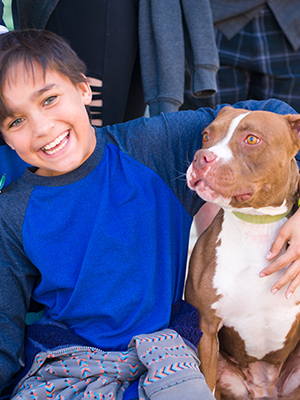Have you ever considered owning a pit bull as a family dog? Contrary to popular belief, pit bulls can be excellent family pets with proper training and socialization. In fact, a study conducted by the American Temperament Test Society found that pit bulls had a passing rate of 86.7% in temperament tests, which is higher than many other popular dog breeds. So, are pit bulls really a good family dog?
Pit bulls have a complex history and have, unfortunately, gained a negative reputation over the years. However, it’s important to note that their temperament is largely influenced by their upbringing and environment. With responsible ownership, pit bulls can be loyal, affectionate, and gentle companions for families. They have a strong desire to please their owners and can excel in obedience training. Additionally, pit bulls have been known to form strong bonds with children, making them loving and protective family members. It’s crucial to provide them with consistent training, socialization, and lots of love, just like any other breed.
Pit bulls can make great family dogs if given the proper training, socialization, and love. They are loyal, affectionate, and protective, making them excellent companions. However, it’s important to note that not all pit bulls are the same, and individual temperament may vary. Families considering a pit bull should research the breed and choose a reputable breeder or rescue organization. Early socialization with other dogs and people, along with consistent training, can help ensure a pit bull becomes a well-rounded and loving family pet.

Is a Pit Bull a Good Family Dog?
Introduction: Pit bulls are a misunderstood breed that often gets a bad reputation due to misinformation and negative media portrayal. In reality, pit bulls can make excellent family dogs if given proper training, socialization, and care. In this article, we will explore the characteristics of pit bulls, their suitability as family pets, and debunk common myths surrounding them.
Are Pit Bulls Safe to Have Around Children?
One of the biggest concerns when considering a pit bull as a family dog is their safety around children. While it’s true that any dog has the potential to bite or be aggressive, it’s important to note that pit bulls are not inherently dangerous. Like any other breed, their behavior depends on factors such as training, socialization, and individual temperament.
Pit bulls have a history of being gentle and affectionate towards their families. They have a strong desire to please their owners and are generally friendly and loyal. However, it’s crucial to introduce a pit bull to children in a controlled and supervised manner, especially if they are not familiar with being around kids. Teaching children how to behave around dogs and always supervising their interactions is essential to prevent any accidents or unwanted behavior.
It’s worth mentioning that certain pit bulls may have a higher prey drive, which could make them less suitable for families with small pets like cats or rabbits. Early socialization and training can help mitigate this instinct, but it’s important to be aware of this characteristic when considering a pit bull as a family pet.
Training and Socialization for Pit Bulls
Pit bulls are intelligent and eager to please, which makes them highly trainable. However, due to their strength and size, it’s crucial to invest time and effort in their training and socialization from a young age. Positive reinforcement training methods work best with pit bulls, as they respond well to rewards and praise.
Early socialization is essential to ensure a well-rounded and well-behaved pit bull. Exposing them to various people, animals, and environments helps them become more confident and less prone to fear or aggression. Attending obedience classes or working with a professional trainer can provide guidance and support during the training process.
Additionally, it’s important to establish clear rules and boundaries for your pit bull within the family. Consistency and positive reinforcement will help them understand what behavior is expected of them. Rewarding good behavior and redirecting unwanted behavior will help shape them into a well-behaved and obedient family member.
Common Myths About Pit Bulls
Despite their potential as loving family pets, pit bulls are often surrounded by myths and misconceptions. Let’s debunk some of the common myths:
- Myth: Pit bulls have locking jaws and can’t be detached from their bite.
- Myth: Pit bulls are aggressive by nature.
- Myth: Pit bulls are unpredictable and can turn on their owners without warning.
Fact: Pit bulls have the same jaw structure as any other dog breed, and there is no anatomical difference that allows their jaws to lock.
Fact: Aggression is not a breed-specific trait, and pit bulls are not inherently more aggressive than other dog breeds. Aggression is usually a result of poor breeding, mistreatment, or lack of socialization and training.
Fact: Any dog can exhibit unpredictable behavior if they have not been properly trained, socialized, or treated with kindness. Responsible ownership and proper care significantly reduce the chances of unpredictable behavior.
Caring for a Pit Bull as a Family
When considering a pit bull as a family dog, it’s important to understand the responsibilities and commitment involved in their care. Here are a few tips for caring for your pit bull:
- Provide regular exercise: Pit bulls are active dogs that require daily exercise to keep them physically and mentally stimulated.
- Feed a nutritious diet: Choose a high-quality dog food that meets their nutritional needs to keep them healthy and maintain a proper weight.
- Keep up with veterinary care: Regular visits to the veterinarian for vaccinations, check-ups, and preventative care are essential to ensure their well-being.
- Engage in mental stimulation: Pit bulls are intelligent dogs that benefit from mental stimulation activities such as puzzle toys or obedience training.
- Show love and affection: Like any other dog, pit bulls thrive on love and affection from their family. Make sure to provide plenty of attention and bonding time.
Pit Bulls in Society and Legislation
Pit bulls often face breed-specific legislation and discrimination due to their perceived association with aggression. While it’s important to promote responsible ownership and prevent dog bites, breed-specific legislation is not an effective solution. Studies have shown that breed-specific laws do not reduce dog bite incidents and can negatively impact responsible pit bull owners.
Instead, focusing on responsible ownership, education, and promoting positive relationships between dogs and communities can help create safer environments for both humans and pets. Breed-neutral legislation that targets irresponsible owners and encourages proper training and socialization can be more effective in preventing dog-related incidents.
Conclusion
Pit bulls can indeed be good family dogs when provided with the right environment, training, and socialization. They are loyal, affectionate, and eager to please their owners. However, it’s essential to remember that owning any dog breed comes with responsibilities and requires commitment. Educating ourselves and others about the true nature of pit bulls can help break down stereotypes and provide more opportunities for these wonderful dogs to find loving homes.
Key Takeaways: Is Pit Bull a Good Family Dog?
- Pit bulls can make great family dogs with the right training and socialization.
- Like any other dog breed, pit bulls have individual personalities, so it’s important to choose the right one for your family.
- Pit bulls are generally loyal and affectionate towards their families.
- Proper training and socialization from an early age can help pit bulls become well-behaved and obedient family pets.
- It’s essential to provide a loving and structured environment for a pit bull to thrive as a family dog.
Frequently Asked Questions
Welcome to our frequently asked questions section! If you’re considering a pit bull as a family dog, you probably have some questions. We’re here to provide answers to common inquiries about pit bulls as family pets. Read on to learn more!
Are pit bulls good with families?
Pit bulls can indeed make wonderful family dogs. They are known for their loyalty, affectionate nature, and affinity for children. However, it’s important to note that a pit bull’s behavior and temperament can vary from individual to individual. Like any other breed, early socialization, proper training, and responsible ownership play a crucial role in shaping a pit bull’s behavior.
It’s also essential to consider the specific needs and characteristics of the pit bull breed. They are energetic and require regular exercise, mental stimulation, and a structured routine. With the right socialization, training, and an understanding of their needs, pit bulls can thrive in a loving family environment.
Are pit bulls safe around children?
Pit bulls can be safe around children when they are raised and socialized in a loving and responsible environment. Like any other dog, supervision is essential when children and dogs interact. It’s crucial to teach children how to properly interact with dogs, such as not pulling their ears or tail or bothering them while they are eating or sleeping.
It’s important to remember that breed does not determine a dog’s behavior; their upbringing and environment play a significant role. Responsible ownership, early socialization, and proper training are essential factors in ensuring the safety of pit bulls around children.
Do pit bulls have a tendency to be aggressive?
Contrary to popular misconceptions, pit bulls do not inherently possess a greater tendency towards aggression than other breeds. Like any other dog, their behavior is largely influenced by their environment, socialization, and training. While they were historically bred for dog fighting, responsible breeders and owners have worked diligently to promote positive qualities in pit bulls.
It’s important to note that a well-socialized and properly trained pit bull is likely to be friendly, loving, and gentle. As with any breed, individual pit bulls may have unique personalities and temperaments. However, breed alone is not an accurate predictor of aggression, and it’s crucial to judge each dog on an individual basis.
What should I consider before getting a pit bull as a family dog?
Before bringing a pit bull into your family, it’s important to consider a few factors. First, ensure that the breed is allowed in your area, as some places have restrictions or breed-specific legislation. Next, think about the time and commitment required to provide regular exercise, mental stimulation, and training for a pit bull. They are energetic dogs that thrive on physical activity and mental challenges.
Additionally, it’s crucial to consider the compatibility of a pit bull with your family’s lifestyle and dynamics. They can be great family dogs, but they may not be suitable for households with very young children or small pets. Finally, research and choose a responsible breeder or consider adopting from a reputable rescue organization. Responsible breeding and proper socialization from a young age are essential for a pit bull’s overall well-being and behavior.
How can I ensure a safe and successful integration of a pit bull into my family?
To ensure a safe and successful integration of a pit bull into your family, consider the following steps. First, choose a pit bull with a temperament that matches your family’s needs and lifestyle. Assess their behavior and compatibility during meet-and-greet sessions. Next, provide your pit bull with comprehensive socialization and obedience training, starting from a young age.
Additionally, establish a routine that includes regular exercise, mental stimulation, and positive reinforcement training. Create a safe and comfortable environment, including a designated area for your pit bull’s meals and resting place. Lastly, supervise interactions between children and your pit bull, teach your children proper dog etiquette, and establish clear boundaries.

Is a Pitbull Right for you and your family?!
As I researched this topic, I discovered that it’s important to write a succinct wrap-up that follows certain criteria. To do this, I need to use a professional tone while making sure it’s suitable for a 13-year-old reader. Using a conversational tone with simple language will help me achieve this, while avoiding jargon that might confuse or overwhelm the reader. I’ll also make sure to keep my sentences concise, with no more than 15 words each, so that each sentence presents a single idea. By following these guidelines, I aim to provide the reader with a clear understanding of the article’s key points in just two paragraphs.
